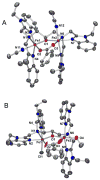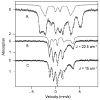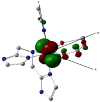Structural, EPR, and Mössbauer characterization of (μ-alkoxo)(μ-carboxylato)diiron(II,III) model complexes for the active sites of mixed-valent diiron enzymes
- PMID: 22360600
- PMCID: PMC3298377
- DOI: 10.1021/ic2021726
Structural, EPR, and Mössbauer characterization of (μ-alkoxo)(μ-carboxylato)diiron(II,III) model complexes for the active sites of mixed-valent diiron enzymes
Abstract
To obtain structural and spectroscopic models for the diiron(II,III) centers in the active sites of diiron enzymes, the (μ-alkoxo)(μ-carboxylato)diiron(II,III) complexes [Fe(II)Fe(III)(N-Et-HPTB)(O(2)CPh)(NCCH(3))(2)](ClO(4))(3) (1) and [Fe(II)Fe(III)(N-Et-HPTB)(O(2)CPh)(Cl)(HOCH(3))](ClO(4))(2) (2) (N-Et-HPTB = N,N,N',N'-tetrakis(2-(1-ethyl-benzimidazolylmethyl))-2-hydroxy-1,3-diaminopropane) have been prepared and characterized by X-ray crystallography, UV-visible absorption, EPR, and Mössbauer spectroscopies. Fe1-Fe2 separations are 3.60 and 3.63 Å, and Fe1-O1-Fe2 bond angles are 128.0° and 129.4° for 1 and 2, respectively. Mössbauer and EPR studies of 1 show that the Fe(III) (S(A) = 5/2) and Fe(II) (S(B) = 2) sites are antiferromagnetically coupled to yield a ground state with S = 1/2 (g= 1.75, 1.88, 1.96); Mössbauer analysis of solid 1 yields J = 22.5 ± 2 cm(-1) for the exchange coupling constant (H = JS(A)·S(B) convention). In addition to the S = 1/2 ground-state spectrum of 1, the EPR signal for the S = 3/2 excited state of the spin ladder can also be observed, the first time such a signal has been detected for an antiferromagnetically coupled diiron(II,III) complex. The anisotropy of the (57)Fe magnetic hyperfine interactions at the Fe(III) site is larger than normally observed in mononuclear complexes and arises from admixing S > 1/2 excited states into the S = 1/2 ground state by zero-field splittings at the two Fe sites. Analysis of the "D/J" mixing has allowed us to extract the zero-field splitting parameters, local g values, and magnetic hyperfine structural parameters for the individual Fe sites. The methodology developed and followed in this analysis is presented in detail. The spin Hamiltonian parameters of 1 are related to the molecular structure with the help of DFT calculations. Contrary to what was assumed in previous studies, our analysis demonstrates that the deviations of the g values from the free electron value (g = 2) for the antiferromagnetically coupled diiron(II,III) core in complex 1 are predominantly determined by the anisotropy of the effective g values of the ferrous ion and only to a lesser extent by the admixture of excited states into ground-state ZFS terms (D/J mixing). The results for 1 are discussed in the context of the data available for diiron(II,III) clusters in proteins and synthetic diiron(II,III) complexes.
Figures









Similar articles
-
Versatile reactivity of a solvent-coordinated diiron(II) compound: synthesis and dioxygen reactivity of a mixed-valent Fe(II)Fe(III) species.Inorg Chem. 2014 Jan 6;53(1):167-81. doi: 10.1021/ic4019585. Epub 2013 Dec 20. Inorg Chem. 2014. PMID: 24359397 Free PMC article.
-
A structural and Mössbauer study of complexes with Fe(2)(micro-O(H))(2) cores: stepwise oxidation from Fe(II)(micro-OH)(2)Fe(II) through Fe(II)(micro-OH)(2)Fe(III) to Fe(III)(micro-O)(micro-OH)Fe(III).Inorg Chem. 2004 May 17;43(10):3067-79. doi: 10.1021/ic030296k. Inorg Chem. 2004. PMID: 15132612
-
Mössbauer, electron paramagnetic resonance, and magnetic susceptibility studies on members of a new family of cyano-bridged 3d-4f complexes. Demonstration of anisotropic exchange in a Fe-Gd complex.Inorg Chem. 2010 Apr 5;49(7):3387-401. doi: 10.1021/ic902516r. Inorg Chem. 2010. PMID: 20225831 Free PMC article.
-
Protoporphyrin IX iron(II) revisited. An overview of the Mössbauer spectroscopic parameters of low-spin porphyrin iron(II) complexes.J Biol Inorg Chem. 2024 Dec;29(7-8):721-761. doi: 10.1007/s00775-024-02075-9. Epub 2024 Oct 10. J Biol Inorg Chem. 2024. PMID: 39384634 Free PMC article. Review.
-
myo-Inositol oxygenase: a radical new pathway for O(2) and C-H activation at a nonheme diiron cluster.Dalton Trans. 2009 Feb 14;(6):905-14. doi: 10.1039/b811885j. Epub 2008 Nov 26. Dalton Trans. 2009. PMID: 19173070 Free PMC article. Review.
Cited by
-
Human mitochondrial ferritin exhibits highly unusual iron-O2 chemistry distinct from that of cytosolic ferritins.Nat Commun. 2025 May 20;16(1):4695. doi: 10.1038/s41467-025-59463-1. Nat Commun. 2025. PMID: 40393986 Free PMC article.
-
Activation and Allostery in a Fungal SAMHD1 Hydrolase: An Evolutionary Blueprint for dNTP Catabolism.JACS Au. 2025 Apr 17;5(4):1862-1874. doi: 10.1021/jacsau.5c00090. eCollection 2025 Apr 28. JACS Au. 2025. PMID: 40313832 Free PMC article.
-
A series of tetraazalene radical-bridged M2 (M = CrIII, MnII, FeII, CoII) complexes with strong magnetic exchange coupling.Chem Sci. 2015 Nov 1;6(11):6639-6648. doi: 10.1039/c5sc02725j. Epub 2015 Aug 18. Chem Sci. 2015. PMID: 29435213 Free PMC article.
-
Pulsed Multifrequency Electron Paramagnetic Resonance Spectroscopy Reveals Key Branch Points for One- vs Two-Electron Reactivity in Mn/Fe Proteins.J Am Chem Soc. 2022 Jul 13;144(27):11991-12006. doi: 10.1021/jacs.1c13738. Epub 2022 Jul 5. J Am Chem Soc. 2022. PMID: 35786920 Free PMC article.
-
Reaction of O2 with a diiron protein generates a mixed-valent Fe2+/Fe3+ center and peroxide.Proc Natl Acad Sci U S A. 2019 Feb 5;116(6):2058-2067. doi: 10.1073/pnas.1809913116. Epub 2019 Jan 18. Proc Natl Acad Sci U S A. 2019. PMID: 30659147 Free PMC article.
References
Publication types
MeSH terms
Substances
Grants and funding
LinkOut - more resources
Full Text Sources
Research Materials

